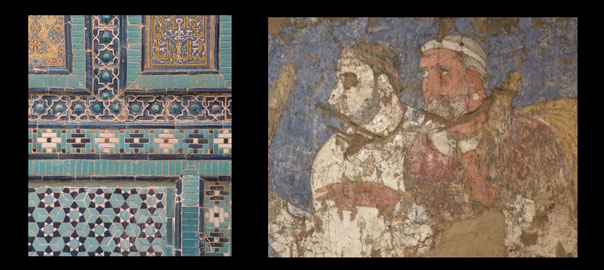For several years I have engaged in an email exchange with the young French scholar Karine Bouchy, who just completed her doctorate in Paris on the gesture in contemporary calligraphy and art. I described to her an experience I had in Samarkand. After visiting endless madrassas and mosques, all decorated with exquisitely patterned tiles, I went to a pre-Islamic building and suddenly saw a fresco of a human face. The shock of coming eye to eye with dead matter, of seeing a human psyche look back from a painted layer of mud, was intense. From this arose an exchange about the power of mimesis (representation or imitation of the visual world in art) versus abstraction and calligraphy. It is a fascinating, but difficult topic. I think that the big question for me is, “What would it be like NOT to be soaked in the art of images?” What does Islamic society have that we do not have, because we are addicted to images and they are not (or were not, before television, and why does TV escape the prohibition on images???). What price do we pay for creating ourselves in our own likeness, and is that what the Semitic law against images is all about? Can we go back to the Ur-moment when an image, scratched in dirt with a stick, first spoke to our eyes, and the first image maker was shocked by dead matter looking back at him, showing him his own face?? In this sense, abstract art and calligraphy are very advanced, images very primitive. It could never have begun with abstraction. With the first image mankind was suddenly different to the animals. Animism could be questioned, the long road to creating gods and then god could begin. In Samarkand: acres of patterned tiles and then, suddenly, a face and a psychology. The reverse would be just as powerful. Rooms and rooms of Rubens, as at the Louvre, and then a page from a Koran. The sharp black lines would shock and draw one in by their purity. Perhaps calligraphy and drawing can be seen as studies of the laws of nature, or at least of our visual perception of nature. Distillations of the laws of form and contrast by which we recognize things as separate from one another. This would be the “truth” element in art. I will never figure it out. Time to go back and check what Gombrich says. I forgot long ago.

Leave a Reply